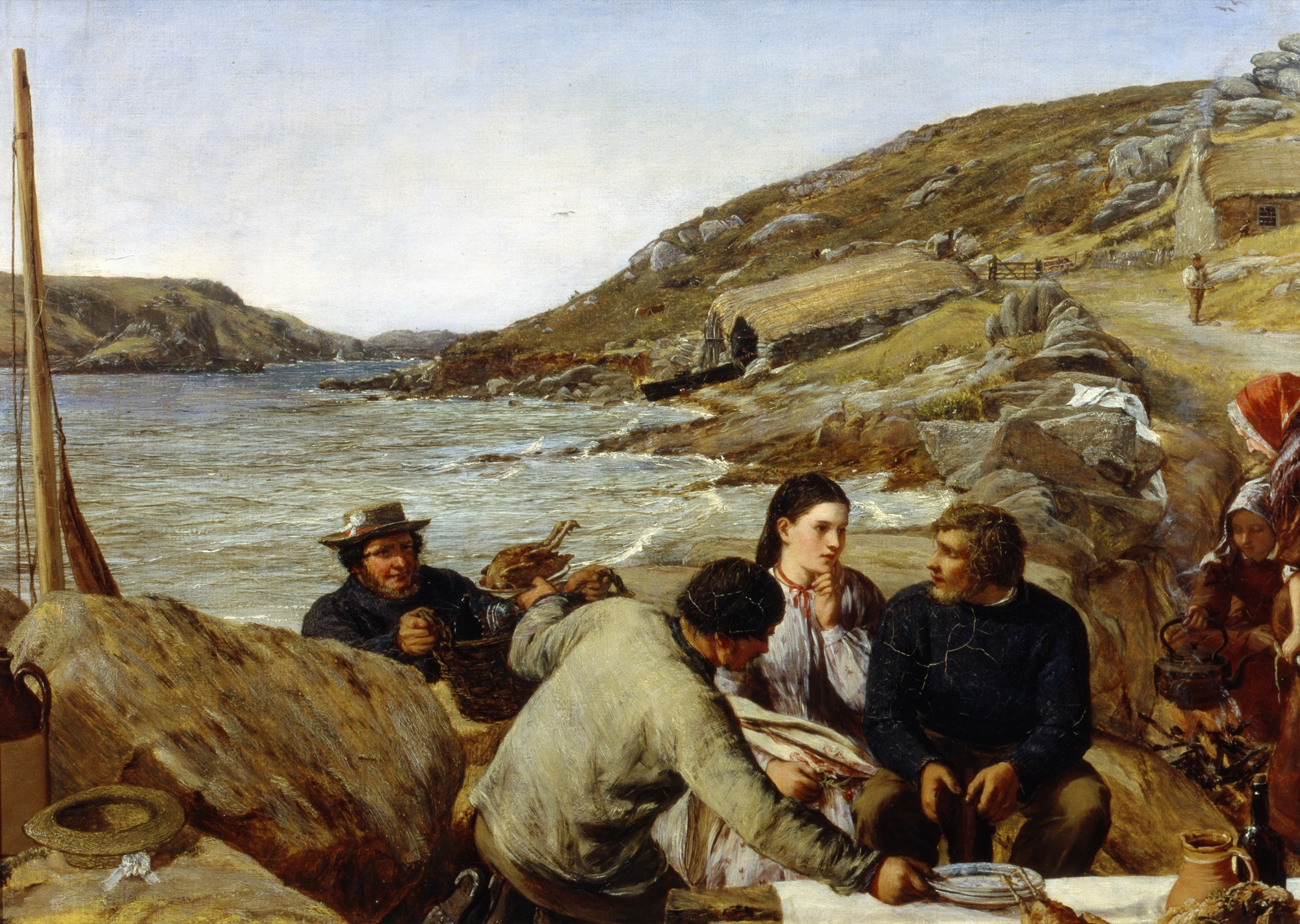Porths and Gigs of the Isles of Scilly
Porths and Gigs of the Isles of Scilly: Home | The Project | Around Hugh Town | Innisidgen, St Mary’s | New Quay, St Mary’s | Peraskin, Agnes | Great Par, Bryher | Beacon Hill, Tresco | Signal Rock, St Martin’s
Porths and Gigs of the Isles of Scilly
Archaeology of the islands’ historic pilot gig boats
A ‘Monument Management Scheme’ project by Cornwall Archaeological Unit (CAU) for Historic England with grant funding also from FiPL (Farming in Protected Landscapes) and Cornwall Archaeological Society

A Sailor’s Wedding Party, 1862, by James Clarke Hook (1819-1907). Brighton & Hove Museums, reproduced by kind permission. The painting shows gig sheds at Point near the quay at New Grimsby on Tresco, before they fell into ruin, with typical thatched roofs and slipways. Thanks to Graeme Kirkham formerly of CAU for bringing attention to the painting and establishing its date.
Introduction
On the Isles of Scilly, seagoing rowing gigs—32-foot boats built from fine elm planks for strength and lightness—once played a vital role in maritime life. These boats carried pilots to ships navigating treacherous waters, rescued lives and cargo from wrecks, served in island farming and in coastal trades such as kelp making, and supported the building and maintenance of lighthouses and other maritime infrastructure.
Though traditional gig rowing declined with the end of pilotage, it has been revived as a sport, and is thriving with clubs in Scilly and Cornwall, and across England. Today, hundreds of crews compete in the annual world championships on Scilly, with some of the islands’ historic gigs still restored and racing.
Scilly’s five main islands hold traces of old gig sheds, some dating back to the 17th century. Recent archaeological discoveries reveal evidence of around 90 sheds (at 60 sites, some sheds being clustered together). Half of these structures still survive, and six sites—or parts of them—are protected as Scheduled Monuments. These remains tell the story of Scilly’s maritime past, recalling remarkable feats of endurance as gig crews battled stormy seas to save ships and lives.
The project
Welcome to this exploration of the archaeology of pilot gigs on Scilly, featuring the results of fieldwork conducted in 2024 across all the main islands. This work includes 3D models and plans created at extra-low tide, offering fresh insights into these historic sites. Led by Cornwall Archaeological Unit (CAU), with invaluable support from local groups and individuals, the Porths and Gigs project is a Monument Management Scheme for Historic England and other partners (see Acknowledgements). The project aims to add to recording and appreciation of Scheduled Monuments and other gig-related archaeology, particularly those on vulnerable coastal sites affected by erosion and rising sea levels.
Download the project report (PDF, 25MB).
Acknowledgements and thanks to Project Partners
The project was by Cornwall Archaeological Unit (CAU), Cornwall Council. The CAU team were Cathy Parkes (project lead), Mark Bowden (survey) and Tom Goskar (scanning and website).
CAU would like to thank all who helped make the project possible. Historic England, the Farming in Protected Landscapes (FiPL) scheme, and Cornwall Archaeological Society (CAS), granted project funding.
Permission for fieldwork was given by Duchy of Cornwall, Tresco Estate, and Isles of Scilly Wildlife Trust. Volunteers Layan Harman, Teän Roberts and Ben Sumpter from Scilly and Cornwall worked as trainees on the surveys. Scilly’s Community Archaeology Group (CAG) cut scrub in advance of recording work.
Ann Preston-Jones (formerly HE) and Katie Read (for FiPL) supported and advised on the project development and funding applications. The Cornish Pilot Gig Association (CPGA), Five Islands Academy, island gig clubs, St Agnes Island Hall, Scilly Arts and Heritage, Visit Isles of Scilly, and World Pilot Gig Championships (WPGC) organisations made contributions in kind and extended outreach. Brighton & Hove Museums, Kresen Kernow, Isles of Scilly Museum, Institute of Cornish Studies, Morrab Library (Penzance), National Maritime Museum (Greenwich), and University of Exeter, supplied images from their archives. Recent photos of gig rowing are courtesy of Steve Strachan, Jonathan Taylor and Heather Wynn, with thanks also to Jade Colton and Aaron Haile.
Information and help was kindly given by many individuals; Patrick Bird, Alison Clough, Rob Davies, Eric Berry, Milly Edwards, Norma Edwards, Chris Evans, Aaron Haile, Tristan Hick, Andrew Hicks, Francis Hicks, Fraser Hicks, Jof Hicks, Johann Hicks, Marigold Hicks, Mike Hicks, Andrew King, Gerald Langdon, Harry Legg, Tamaryn Legg, Nick Jenkins, Richard Jenkins, Stuart Jenkins, Charles Johns, Mary Mac Kay, Graeme Kirkham, Dr Joanna Mattingly, Diana Mompoloki, Joby Newton, Dr Oliver Padel, Adrian Pearce, James Pearce, Richard Pearce, Terry Perkins, Jeremy Phillips, Chris Potterton, Ann Preston-Jones, Debbie Purser, Katharine Sawyer, Lou Simmonds, David Stedeford, Michael Tangye, Jonathan Taylor, Alfred Trenear, Cathy Tyers, Rachael Utting, Steve Walder, John Williams, and Mandy Williams.
Views and recommendations expressed by CAU in this website are presented in good faith on the basis of professional judgement and information currently available.
Porths and Gigs of the Isles of Scilly: Home | The Project | Around Hugh Town | Innisidgen, St Mary’s | New Quay, St Mary’s | Peraskin, Agnes | Great Par, Bryher | Beacon Hill, Tresco | Signal Rock, St Martin’s